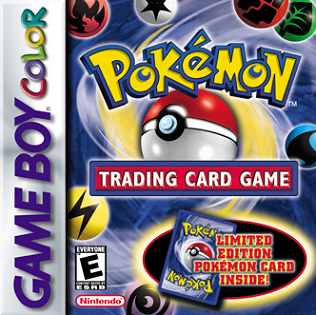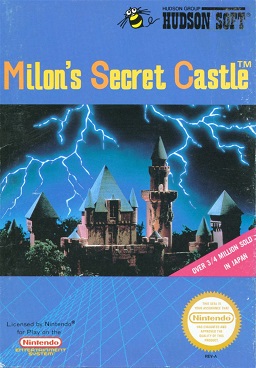
R-Type is a horizontally scrolling shooter arcade video game developed and released by Irem in 1987 and the first game in the R-Type series. The player controls a star ship, the R-9 "Arrowhead", in its efforts to destroy the Bydo, a powerful alien race bent on wiping out all of mankind. The R-9 can acquire a glowing orbicular device called a "Force", protecting it from enemy fire and providing additional firepower. The arcade version was distributed by Nintendo in North America; it is the last arcade title Nintendo distributed.

The Slime series is a spinoff series of games from Dragon Quest featuring its Slime character. Three games have been released, the second of which, Dragon Quest Heroes: Rocket Slime, has been released in North America.

Pokémon Trading Card Game is a video game adaptation of the Pokémon tabletop card game for the Game Boy Color. Developed by Hudson Soft and Creatures, and published by Nintendo, it was initially released in Japan in 1998, and in the West in 2000. The game includes the first three sets of the trading card game, as well as exclusive cards not available elsewhere. The game was released as part of the Nintendo Switch Online service on August 8, 2023.

Metal Gear Solid, released in Japan as Metal Gear: Ghost Babel, is a 2000 action-adventure stealth video game developed and published by Konami for the Game Boy Color. The game began development after Konami Computer Entertainment Japan were commissioned by Konami's European branch to develop a portable adaptation of their 1998 PlayStation game of the same title. However, the Game Boy Color version is not a port of the original PlayStation version, nor does it adapt the same story, but instead takes place in an alternative continuity set seven years after the events of the original Metal Gear (1987). Tose assisted on the development.
The Wars series, also known as Famicom Wars and Advance Wars, is a series of military-themed turn-based strategy video games, predominantly developed by Intelligent Systems and published by Nintendo. The series debuted in Japan in August of 1988 with the original Famicom Wars, followed by sequels on the Super Famicom and Game Boy. These early installments were released in Japan, with Advance Wars (2001) being the first to reach the North American and European markets. Advance Wars was released in the United States on September 10, 2001, but put on hold in Japan and Europe due to the September 11 attacks. Although released in Europe in January 2002, neither Game Boy Advance game was released in Japan until the Game Boy Wars Advance 1+2 compilation, which released for the Game Boy Advance on November 25, 2004. The success of Advance Wars in the West is frequently credited as a driving force for Nintendo bringing Intelligent Systems' franchise Fire Emblem outside of Japan, as both series share a similar tactical gameplay style.
Super Smash Bros. is a crossover fighting game series published by Nintendo. The series was created by Masahiro Sakurai, who has directed every game in the series. The series is known for its unique gameplay objective which differs from that of traditional fighters, in that the aim is to increase damage counters and knock opponents off the stage instead of depleting life bars.

Milon's Secret Castle, known in Japan as Meikyū Kumikyoku: Milon no Daibōken, is a 1986 action-adventure game released by Hudson Soft for the NES. A Game Boy version was released in 1993. A sequel, DoReMi Fantasy, was released in 1996 for the Super Famicom.

Hudson's Adventure Island, known as Takahashi Meijin no Bōken Jima in Japan and also known as Adventure Island, is a side-scrolling platform game produced by Hudson Soft that was released in Japan for the Famicom and MSX on September 12, 1986. Adventure Island was released in North America for the Nintendo Entertainment System in 1988 and in the PAL region in 1992.

Military Madness is a 1989 turn-based strategy video game originally developed and published by Hudson Soft in Japan and NEC in North America for the TurboGrafx-16. It is the first entry in the Nectaris series. Set in the year 2089, players take command of the Allied-Union forces in a desperate offense against the Axis-Xenon Empire army on the Moon before they launch the S.A.M. weapon to obliterate Earth. Its gameplay consists of moving units into positions to confront enemies in turn-based encounters determined by multiple factors, capturing factories to produce resources and repair units in order to occupy the enemy prison camp or destroy all enemy forces.

Famicom Wars is a wargame developed by Nintendo and Intelligent Systems and published by Nintendo for the Famicom. It was released on August 12, 1988 in Japan. It was later re-released on Virtual Console. It is the first game in the Wars series.
The Virtual Console is a line of downloadable video games for Nintendo's Wii and Wii U home video game consoles and the Nintendo 3DS family of systems.

Mega Man Xtreme is a 2000 video game developed by Capcom for the Game Boy Color handheld console. It is a spin-off title in the Mega Man X series of video games that originated on the Super Nintendo Entertainment System. Mega Man Xtreme takes place within the series timeline during the 22nd century, in which a group of "Maverick" androids called the "Shadow Hunters" hack into the world's "Mother Computer" system, destabilize all of the networks, and allow other Mavericks to cause rampant destruction all over the world. The heroic "Maverick Hunter" X is tasked with going into cyberspace to relive his past missions and put a stop to the group's plans.
Star Soldier is a series of scrolling shooters mainly developed by Hudson Soft. Konami has owned the rights to the series since their absorption of Hudson Soft in 2012. The first game, named Star Soldier, appeared on the MSX and NES in 1986, and the series has continued on various gaming systems. Star Soldier itself has received enhanced remakes for both the GameCube and PlayStation 2 in 2003, and a different remake for the PlayStation Portable in 2005, while the latest installment of the series was released on the Wii as a WiiWare game in 2008. In addition, Super Star Soldier, Final Soldier, Soldier Blade and Star Parodier have been re-released on the Wii's Virtual Console and on the Japanese PC Engine's Best Collection lineup for the PSP. The Star Soldier games are best known for their distinctive music, unique weapon power-ups, and a special time attack high score mode called "Caravan Mode".

Soldier Blade is a 1992 vertically scrolling shooter developed and published by Hudson Soft for the TurboGrafx-16. Controlling the titular starship, the player is tasked with completing each of the game's seven stages in order to wipe out the Zeograd Army, an alien race bent on conquering Earth. The game is the fourth entry in the Star Soldier series and shares many similarities with its predecessor Super Star Soldier, with Soldier Blade having a heavy emphasis on speed.

Mario is a Japanese multimedia franchise created by Japanese game designer Shigeru Miyamoto for video game company Nintendo which produces and publishes its installments. Starring the titular Italian plumber Mario, it is primarily a video game franchise, but has extended to other forms of media, including television series, comic books, a 1993 feature film, a 2023 animated film and theme park attractions. The series' first installment was 1983's Mario Bros., although Mario had made his first appearance in 1981's arcade game Donkey Kong, and had already been featured in several games of the Donkey Kong and Game & Watch series. The Mario games have been developed by a wide variety of developers including Nintendo, Hudson Soft, and AlphaDream. Mario games have been released almost exclusively for Nintendo's various video game consoles and handhelds, from the third generation onward.

Tetris: Axis, released as Tetris in some regions, is a puzzle video game developed by Hudson Soft and Bandai for the Nintendo 3DS. The game was released in all regions in October 2011 and was published by Namco Bandai Games in Japan, Nintendo in North America, and Tetris Online in Europe and Australia.

Fire Emblem Awakening is a 2012 tactical role-playing game developed by Intelligent Systems and published by Nintendo for the Nintendo 3DS. It is an installment of the Fire Emblem series, and the first to be developed for the Nintendo 3DS. The gameplay, like previous Fire Emblem games, focuses on the tactical movement of characters across a grid-based battlefield and fighting enemy units. Other features include the ability to build and foster relationships between characters to improve their abilities and multiple camera perspectives in battle.

Super Robot Wars UX is a tactical role-playing game for the Nintendo 3DS developed by Banpresto and published by Bandai Namco Games. It is the first Super Robot Wars (SRW) game for the 3DS and was released in Japan on March 14, 2013. The theme of this game is "Possibilities".

Kirby Battle Royale is a brawler multiplayer video game in the Kirby series. Developed by HAL Laboratory and published by Nintendo, the game was released on the Nintendo 3DS handheld game console in Europe and Japan in November 2017, and in North America in January 2018.

Bomberman is the working title of a cancelled action-adventure video game that was in development by Hudson Soft and planned to be published by Konami for the Nintendo 3DS. Intended to be a unique entry in the Bomberman franchise, it was going to feature its own dedicated single-player campaign and multiplayer mode with support for up to four local players and eight players via online support.
















